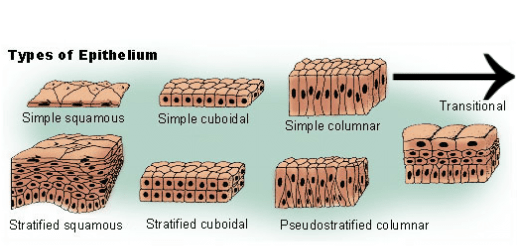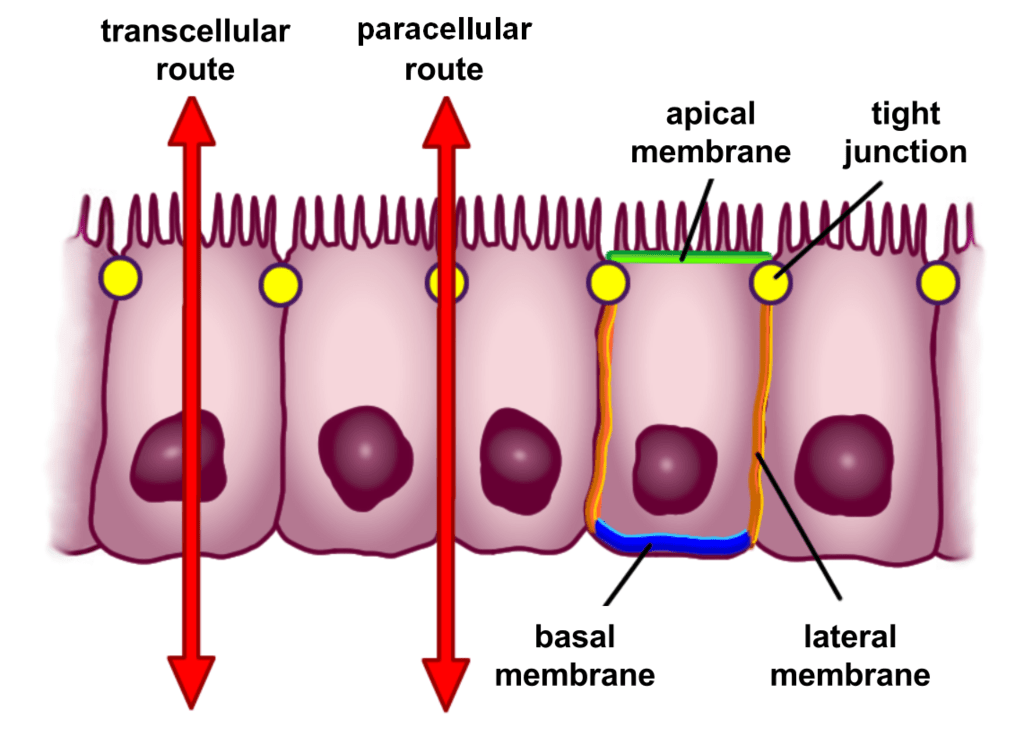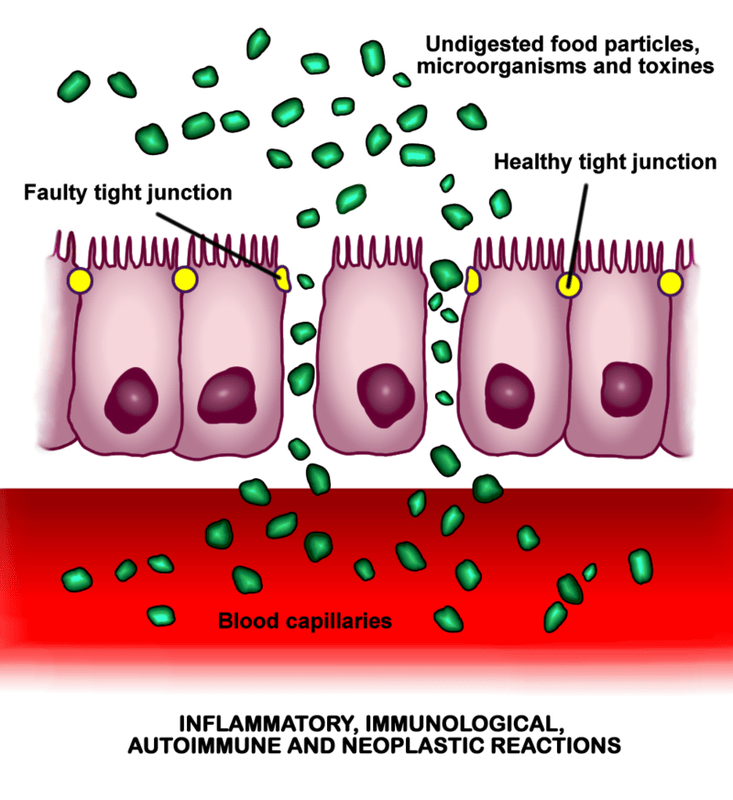INFLAMMATION, PAIN, DISEASE, AND THE LEAKIES
(Leaky Gut, Leaky Brain, Leaky Lung, Leaky Cord, Leaky Nerve, etc, etc, etc)

Leaky Gut Syndrome. If you have chronic health conditions or chronic pain, I certainly hope you are at least somewhat familiar with this all-too-common health problem. Today I am not only going to show you why LGS is linked to so many terrible physical ailments, but I am going to help you understand what happens in a leaky gut using several simple pictures.
If you find looking at the peer-reviewed science on LGS boring, feel free to skip down to the pics, as the studies are not necessary for getting the gist of this post. Follow along as I show you how a Leaky Gut is the common denominator between inflammation, gluten sensitivity, autoimmune diseases, dysbiosis, and chronic pain.
While researching this post, I was curious to see what that shinning pillar of truth and light, Wikipedia, had to say. Upon looking up ‘Leaky Gut Syndrome,’ I was surprised to learn that…
“proponents claim that a “leaky gut” causes chronic inflammation throughout the body that results in a wide range of conditions, including chronic fatigue syndrome, rheumatoid arthritis, lupus, migraines, multiple sclerosis, and autism. As of 2016, there is little evidence to support the hypothesis that leaky gut syndrome directly causes this wide array of diseases.”
But after looking at who Wiki’s “expert” author was for this entry, I clearly understood what was going on. Using the discredited psychiatrist Stephan Barret (HERE; a colleague of HALL & GORSKI) as the source of their information, Wiki went on to describe Leaky Gut Syndrome as…
“a hypothetical, medically unrecognized condition… claims for the existence of “leaky gut syndrome” as a distinct medical condition are mostly made by nutritionists and practitioners of alternative medicine… an opportunity to promote a number of alternative health remedies including diets, herbal preparations, dietary supplements… probiotics, herbal remedies, gluten-free foods, and low FODMAP, low sugar, or antifungal diets, but there is little evidence that the treatments offered are of benefit.”
In light of the peer-reviewed science — much of it decades old — this is a harsh indictment for us ALTERNATIVE MEDICINE QUACKS.
Despite what Barrett says, there is a veritable mountain of peer-reviewed evidence that Leaky Gut Syndrome not only exists, but is intimately associated with massive amounts of physical suffering and CHRONIC PAIN — particularly in those consuming large quantities of HEAVILY PROCESSED CARBOHYDRATES that are ubiquitous to the SAD (Standard American Diet).
Those who follow my blog won’t be surprised to see that I have written about every topic Barrett mentions, along with the intimate way(s) they are all related to each other. I go a step further by always giving you the study’s name as well as the journal it came from.
If you go to PubMed, you can see just how few studies have been specifically done on LEAKY GUT SYNDROME — only 180. However, plug in ‘Increased Intestinal Permeability‘ and that number jumps to 3,500. This doesn’t count searches for other terms commonly associated with LGS (increased, intestinal permeability, intestinal hyperpermeability, abnormal gut permeability, gut barrier insufficiency, mucosal dysfunction, intestinal epithelial aberrations, along with dozens of others). By my reckoning, there are at least 12,000 studies related to this topic, and maybe several times that number.
Just to show you how far removed from reality Barrett and his brethren are, if we take a quick look at Intestinal Hyperpermeability as it relates to MS, we immediately find two studies that were published over twenty years apart, but telling us essentially the same thing.
- 20 years ago in December, the journal Digestive Diseases and Sciences (Multiple Sclerosis Patients have Peripheral Blood CD45RO+ B Cells and Increased Intestinal Permeability) concluded that, “Five of 20 MS patients had increased intestinal permeability, a finding not previously reported. A subgroup of MS patients has increased intestinal permeability.“
- In June of this year, the journal Multiple Sclerosis (Altered Intestinal Permeability in Patients with Relapsing-Remitting Multiple Sclerosis: A Pilot Study) revealed that, “Alterations of intestinal permeability may contribute to the pathophysiology of immune-mediated [autoimmune] diseases. The proportion of participants with increased intestinal permeability was significantly higher in patients than in [controls]. The relatively high proportion of intestinal permeability changes in relapsing-remitting multiple sclerosis patients seems to confirm our hypothesis.“
The thing is, we can do the same thing with any health problem or disease we want. Let’s try plugging in ASTHMA — now known to be an autoimmune disease — and see what happens.
- Twenty years ago this past summer, the June 1996 issue of the Journal of Allergy and Clinical Immunology (Increased Intestinal Permeability in Bronchial Asthma) revealed that, “Our results support the hypothesis that a general defect of the whole [Gut] mucosal system is present as a cause or a consequence of bronchial asthma.” They didn’t know whether LGS was the cause or effect, but they knew it was there.
- Eight years later, the March 2004 issue of the Archives of Diseases in Childhood (Intestinal Permeability is Increased in Bronchial Asthma) went a step further by concluding, “Intestinal permeability is increased in children with asthma, suggesting that the whole mucosal system may be affected.”
- Six years ago next month, the November 2010 issue of Allergy, Asthma, and Clinical Immunology (Altered Gastrointestinal Mucosal Permeability in Asthma) showed that, “Abnormal gastrointestinal permeability has been implicated in immunologic disease, including Crohn’s disease and celiac disease, but also including non-intestinal diseases such as diabetes and multiple sclerosis. This study demonstrates an increase in gastrointestinal permeability in the small intestine of asthmatic patients, illustrating an association between abnormal gastrointestinal permeability and current asthma.”
- In April 2014, the journal Clinical & Investigative Medicine (High Prevalence of Abnormal Gastrointestinal Permeability in Moderate-Severe Asthma) not surprisingly showed a strong link between LGS and asthma. “Although evidence in the literature demonstrates mucosal abnormalities of the digestive barrier in asthma, previous studies have assessed only colonic permeability, while ignoring the small intestine. Fourteen patients with moderate to severe asthma were studied, half of whom were found to have abnormal gastrointestinal permeability. This study demonstrated our ability to identify abnormal gastrointestinal permeability in the small intestines of patients with asthma.“
How about taking a look at Leaky Gut as it relates to PARKINSON’S DISEASE?
- The month I was married (March, 1996) the Postgraduate Medical Journal (Intestinal Permeability and Orocaecal Transit Time in Elderly Patients with Parkinson’s Disease) concluded that among other things, “Intestinal permeability was deranged.” In other words, the gut was hyperpermeable.
- In 2011, the medical journal PLoS One (Increased Intestinal Permeability Correlates with Sigmoid Mucosa Alpha-Synuclein Staining and Endotoxin Exposure Markers in Early Parkinson’s Disease) concluded that, “Parkinson’s disease is the second most common neurodegenerative disorder of aging. The pathological hallmark of Parkinson’s Disease is neuronal inclusions termed Lewy bodies whose main component is alpha-synuclein protein. The finding of these Lewy bodies in the intestinal enteric nerves led to the hypothesis that the intestine might be an early site of Parkinson’s Disease disease in response to an environmental toxin or pathogen. One potential mechanism for environmental toxin(s) and proinflammatory luminal products to gain access to mucosal neuronal tissue and promote oxidative stress is compromised intestinal barrier integrity. Our data show that our Parkinson’s Disease subjects exhibit significantly greater intestinal permeability (gut leakiness) than controls. These data represent not only the first demonstration of abnormal intestinal permeability in Parkinson’s Disease subjects but also the first correlation of increased intestinal permeability in Parkinson’s Disease with intestinal alpha-synuclein (the hallmark of Parkinson’s Disease).”
- Last March Acta Neuropathological Communications (Structural Alterations of the Intestinal Epithelial Barrier in Parkinson’s Disease) hit us with more revelations. “Functional and morphological alterations of the intestinal epithelial barrier have been consistently reported in digestive disorders such as irritable bowel syndrome and inflammatory bowel disease. There is mounting evidence that Parkinson’s disease is not only a brain disease but also a digestive disorder. Gastrointestinal involvement is a frequent and early event in the course of Parkinson’s Disease, and it may be critically involved in the early development of the disease. Our findings provide evidence that the intestinal epithelial barrier is morphologically altered in Parkinson’s Disease and further reinforce the potential role of the gastrointestinal tract in the initiation and/or the progression of the disease.“
- A month later, scientists and doctors working in both Missouri and Illinois published a study (Leaky Intestine and Impaired Microbiome in an Amyotrophic Lateral Sclerosis Mouse Model) in the journal Physiology Reports showing that the link between abnormal gut permeability and Parkinson’s Disease was well established — almost passe. They discussed it’s link to ALS (Amytrophic Lateral Sclerosis aka Lou Gehrig’s Disease). “Emerging evidence has demonstrated that intestinal homeostasis and the microbiome play essential roles in neurological diseases, such as Parkinson’s disease….. Taken together, our study suggests a potential novel role of the intestinal epithelium and microbiome in the progression of ALS.“
Or DEPRESSION?
- The February 2008 issue of Neuro Endocronological Letters (The Gut-Brain Barrier in Major Depression: Intestinal Mucosal Dysfunction with an Increased Translocation of LPS From Gram Negative Enterobacteria (Leaky Gut) Plays a Role in the Inflammatory Pathophysiology of Depression) showed such a strong link between Depression and Leaky Gut that they concluded, “There is now evidence that major depression is accompanied by an activation of the inflammatory response system and that pro-inflammatory cytokines and lipopolysacharide may induce depressive symptoms. It is suggested that patients with major depression should be checked for leaky gut and accordingly treated for leaky gut.“
- A year ago this month, Frontiers in Cellular Neuroscience (Breaking Down the Barriers: The Gut Microbiome, Intestinal Permeability and Stress-Related Psychiatric Disorders) revealed that, “The emerging links between our gut microbiome and the central nervous system are regarded as a paradigm shift in neuroscience. Mounting evidence broadly suggests that the gut microbiota can modulate brain development, function and behavior by immune, endocrine and neural pathways of the brain-gut-microbiota axis. The concept that a “leaky gut” may facilitate communication between the microbiota and these key signaling pathways has gained traction. Deficits in intestinal permeability may underpin the chronic low-grade inflammation observed in disorders such as depression and the gut microbiome plays a critical role in regulating intestinal permeability.” In the last sentence you can clearly see how a intestinal permeability is affected by the microbiome and vice versa.
- This past April’s issue of The Journal of Neurogastroenterology and Motility (Modulatory Effects of Gut Microbiota on the Central Nervous System: How Gut Could Play a Role in Neuropsychiatric Health and Diseases) stated, “Gut microbiome is an integral part of the Gut-Brain axis. It is becoming increasingly recognized that the presence of a healthy and diverse gut microbiota is important to normal cognitive and emotional processing. It was known that altered emotional state and chronic stress can change the composition of gut microbiome, but it is becoming more evident that interaction between gut microbiome and central nervous system is bidirectional. Alteration in the composition of the gut microbiome can potentially lead to increased intestinal permeability and impair the function of the intestinal barrier. Subsequently, neuro-active compounds and metabolites can gain access to the areas within the central nervous system that regulate cognition and emotional responses.” No wonder Depression is listed among those health issues intimately related to inflammation.
Or CHRONIC PAIN?
- According to a nine year old study from the journal Rheumatology (Altered Intestinal Permeability in Patients with Primary Fibromyalgia and in Patients with Complex Regional Pain Syndrome), “The pain intensity of patients with fibromyalgia has recently been reported to be correlated with the degree of small intestinal bacterial overgrowth (SIBO). SIBO is often associated with an increased intestinal permeability. The intestinal permeability values were significantly increased in the patient groups. Intestinal permeabilities in primary fibromyalgia and, unexpectedly, CRPS (Complex Regional Pain Syndrome) are increased.” Making this problem even bigger is the fact that numerous drugs, including most of those given for pain, cause increased intestinal permeability. And if you’re not sure what SIBO is, I’ve written several articles about.
Or even CANCER?
- The April 1999 issue of Carcinogenesis (Increased Tight Junctional Permeability is Associated with the Development of Colon Cancer) revealed that, “Barrier function is provided by the epithelial cells and the tight junctions that connect them. Diseases of the colon characterized by increased permeability, like Crohn’s and ulcerative colitis are typically associated with a high frequency of genetic alterations and colon cancer. We postulate that an increase in tight junction permeability constitutes a critical change for determining the growth of transformed epithelial cells into tumors, acting as an epigenetic tumor promotional event in colon cancer.” I’ll discuss other epigenetic factors in a moment.
- Writing about a study done by Philadelphia’s Thomas Jefferson University and published in PLoS One, ScienceDaily (Stronger Intestinal Barrier May Prevent Cancer in the Rest of the Body...) let the world know in February of 2012 that, “A leaky gut may be the root of cancers forming in the rest of the body. It appears that the hormone receptor guanylyl cyclase — a previously identified tumor suppressor that exists in the intestinal tract — plays a key role in strengthening the body’s intestinal barrier, which helps separate the gut world from the rest of the body, and possibly keeps cancer at bay. Without the receptor, that barrier weakens.“
- Furthermore, dozens of studies have revealed that chemotherapy for a wide array of cancers frequently leads to increased intestinal permeability. The January 2014 issue of Nutrition and Cancer (Changes in Intestinal Permeability and Nutritional Status After Cytotoxic Therapy in Patients with Cancer) stated that, “Abnormal intestinal permeability… and its possible relationship with intestinal alterations… may be associated with poor nutritional status in cancer patients.” And here’s the thing about nutritional status in cancer patients — the medical community will prove unhelpful in this endeavor as they do not recognize nutrition as important in the battle against cancer (HERE). It also helps explain why antibiotics are so strongly linked not only to LGS, but to cancer as well (HERE).
The point is, I could go on and on and on with this exercise, showing that no matter what sort of health issue you have, you are far more likely to have some degree of intestinal hyperpermeability (a “leaky” gut). Furthermore, most of these chronic conditions are going to be associated with higher levels of pain.
And on top of everything else, you can see from the dates of some of these studies that such findings are neither new nor controversial. Now let’s shift gears and talk a bit about the anatomy and physiology of the ‘Leakies’ — complete with a few pictures.
ANATOMY & PHYSIOLOGY OF THE ‘LEAKIES’
The Photographer and Jstein I’ve shown you time and time again how NON-CELIAC GLUTEN SENSITIVITY is strongly and intimately related to Leaky Gut Syndrome as well as any number of Autoimmune Diseases (HERE) such as LUPUS, RHEUMATOID ARTHRITIS, and MULTIPLE SCLEROSIS. Furthermore, I’ve shown you how it’s related to things like AUTISM and MIGRAINE HEADACHES as well.
Beyond that, LGS is commonly found in peer-review in tandem with nasty health issues such as FODMAP SENSITIVITIES, SIBO, FUNGUS / YEAST OVERGROWTHS, MOLD, SUGAR ADDICTIONS, ANTIBIOTIC OVERUSE, DYSBIOSIS, and a MICROBIOME that’s gone F.U.B.A.R. because of it all.
In fact, what you start to see as you study this issue is that all these diseases are really one big continuum of dysfunction — physiology gone haywire, usually in the absence of gross pathology. It’s the reason so many chronic health conditions don’t offer much as far as positive test results when you go to your doctor feeling like crap (HERE). Fail to grasp this and you’ll find yourself trapped on the MEDICAL MERRY-GO-ROUND, taking all the very meds that Barrett and his ilk so heartily promote for BIG PHARMA under the guise of EVIDENCE-BASED MEDICINE.
Because there is such an absurd amount of scientific evidence for Leaky Gut, and because if you have chronic illnesses of any sort, there’s a good chance that you are dealing with this problem on some level, it is important you know what it is and how it works. Firstly, it is absolutely imperative that you understand what INFLAMMATION is and what it does. I continue to stand by my statement that 999 people out of 1,000 — including many healthcare professionals — do not understand inflammation and cannot explain it in a meaningful way.
When it comes to inflammation, Leaky Gut is unique because it can both cause inflammation and be caused by inflammation (HERE). Bottom line, if you don’t have a good handle on Inflammation, you have very little chance of actually getting better.
Secondly, because it is going to provide the same basic anatomical and physiological model of the other “Leakies” (Leaky Brain Syndrome, Leaky Nerve Syndrome, LEAKY CORD SYNDROME, Leaky Lung Syndrome, etc, etc), understanding a Leaky Gut will help you understand the hidden cause of a plethora of health issues. Let’s get the ball rolling by discussing epithelial tissue — in this case, simple columnar epithelium, because that’s what’s found in the Gut lining.
THE SMALL INTESTINE, SIMPLE COLUMNAR EPITHELIUM, TIGHT JUNCTIONS
THE BASEMENT MEMBRANE, AND THE CAPILLARY BED (BLOOD SUPPLY)


As you can see from the picture above, there are several types of epithelium. The columnar epithelium (it looks like columns) has the Tri-Cellular Junctions (TCJ’s), at the point where three cells touch each other. The thing is, the cells don’t really touch each other since each cell has a membranes (LIPID BILAYERS) made of cholesterol separating it from the other.
Deep to the layer of epithelium is a capillary bed. Capillaries are the tiniest blood vessels, so small that RBC’s (red blood cells) must flow through one at a time. Underneath the layer of epithelium and covering the capillary are what are called “basement membranes”.
What you need to remember here is that when we talk about GUT HEALTH, the “Gut” is one cell-layer thick, and this is where the barrier is. Another well-known barrier system that works in an almost identical fashion is the BBB (blood/brain barrier). Whether talking about the Gut, the BRAIN, the cord, the lungs, etc, the gates in these barriers are known as “tight junctions”.
If you look at the pictures directly below, you will notice the “tight junctions”. Although these tight junctions are found near the top of the cell, there are looser connections below this called “gap junctions” (not shown).
When normal digestion occurs (SEE ENDOGUT), tiny particles of nutrients along with H2O are allowed to pass through the tight junctions, through the basal membranes, and into the capillaries, where they will be taken where needed for growth, repair, regeneration, energy, hydration, etc, etc.
As long as the tight junctions are doing their job and only allowing in what should go in, all is well with the world. But what would happen if these “tight junctions” were to lose their tightness? What happens when things go awry in the body’s barrier systems? Can anyone say ‘leaky’?
LEAKY ‘INCREASED PERMEABILITY‘ SYNDROMES


Because the transcellular route of transport as seen in the red line in the pic above left is much slower, requires carrier molecules, and takes a good deal of cellular energy in the form of ATP, it is not the route we are talking about today. Instead, we are discussing the paracellular route, controlled almost entirely by the integrity of the tight junctions.
When these tight junctions fail; instead of having nice tiny molecules making their way into the capillaries, an array of things that should not be there start getting into the blood stream. These include, but are not limited to undigested or partially-digested food particles, PARASITES, bacteria, toxins, and any number of others.
The bottom line is that if unwelcome guests manage to get past the barriers and into the blood, they are likely to create an immune response. The body recognizes these entities as foreign invaders and begins attacking. What’s interesting (in a terrible way) is that once the tight junctions are opened and the body starts attacking the onslaught of invaders, it often starts attacking itself. This is known as AUTOIMMUNITY.
If you are interested in looking at a short list of some of the more common autoimmune diseases (many of which you likely were unaware were autoimmune), HERE it is.
In the brain, things get even more interesting because head injuries themselves can cause hyperpermeability of the BLOOD BRAIN BARRIER. This not only allows the molecules we’ve already discussed to get into the brain’s blood supply, but allows the cellular contents of dead or dying brain tissues to get in there as well.
As long as brain tissue is where it should be, the body is more apt to be fine with it. But when significant amounts start getting into places it should not be, such as the blood stream; as crazy as it sounds, the body will often start making antibodies and mounting attacks against its own brain (HERE, HERE, or HERE).
This can lead to a crazy array of problems including GLIAL CELL ACTIVATION, subsequent to something called CENTRAL SENSITIZATION (hellish chronic pain that has the potential to play on a continuous, never-ending loop).
WHAT CAUSES “THE LEAKIES” AND WHAT CAN BE DONE TO FIX THE LEAKS?


I think that the reason there are so many deniers in the practicing medical profession when it comes VARIOUS FORMS OF THE LEAKIES (the medical research community KNOWS BETTER) is because they have no idea how to address it — even though there are simple and inexpensive DIY home-testing kits available.
The “Leakies” are so incredibly detrimental to health because they both drive and are driven by inflammatory processes in the body. In other words, they are their own vicious cycle (HERE). This is why the only way to successfully deal with the ‘Leakies’ is to figure out what’s driving the inflammation in your life and address it.
Knowing this takes some of the mystery out of solving the Leakies, helping you solve your chronic health conditions. All you have to do is get Mr. Leaky to throw his monkey wrench in the gears of your body’s inflammatory machinery. How do we go about doing this? For starters, let’s look at Gluten.
Remember the quotes from Wikipedia concerning Leaky Gut Syndrome from the beginning of this article? Lets take a cherry-picked glimpse their piece on “Intestinal Permeability”.
The barrier formed by the intestinal epithelium separates the external environment from the body and is the most extensive and important mucosal surface of body and serves two crucial functions. First, it acts as a barrier, preventing the entry of harmful substances such as foreign antigens, toxins and microorganisms. Second, it acts as a selective filter which facilitates the uptake of nutrients, electrolytes, water and other beneficial substances.
One way in which intestinal permeability is modulated is via receptors in cells in the intestinal epithelium, which respond to zonulin. Gliadin (a glycoprotein found in wheat) activates zonulin signaling irrespective of the genetic expression of autoimmunity, leading to increased intestinal permeability. Bacterial pathogens modulate intestinal tight junction structure and function, and these effects may contribute to the development of chronic intestinal disorders. Stress and infections also seem to cause perturbations in intestinal permeability.
Opening the intercellular tight junctions (increased intestinal permeability) can allow microbes, microbial products, and foreign antigens into the body. This can result in activation of the immune system and secretion of inflammatory mediators.
After this, the author(s) list a slew of the diseases caused by these inflammatory mediators. If you want to see not only this list of diseases but the list of mediators as well, HERE is the link. Again, a failure to understand inflammation means that solving (or at the very least, dampening) the effects of the Leaky Gut and other Leakies will be unlikely. Furthermore, there are two critical points to be made in this paragraph.
First is that gliadin is a component of GLUTEN. Gluten is intimately related to autoimmunity because (secondly) REGARDLESS OF YOUR GENETICS (irrespective of genetic expression — these are the epigentic factors I told you we would get to), it activates zonulin. What the heck is zonulin?
Discovered in Y2K by DR. ALESSIO FASANO and his team from the University of Maryland’s School of Medicine, zonulin is not only the chief modulator of the tight junctions — it’s the only known modulator of the tight junctions. And as you can see above, the two things that modulate zonulin (increased zonulin breaks the tight junctions) are DYSBIOTIC INFECTIONS (bacteria, mold, yeast, virus, and other nasty critters) and gluten.
For those who don’t think this is important, you can read the short article I wrote on this topic a few years ago (HERE) or you can read the words of Dr. Fasano himself from the 2012 issue of the Annals of the New York Academy of Sciences (Zonulin, Regulation of Tight Junctions, and Autoimmune Diseases). After invoking the HYGIENE HYPOTHESIS, Fasano went on to say (extremely cherry-picked as are all quotes in this post)…..
Collectively, autoimmune diseases are highly prevalent in the U.S., affecting between 14.7 and 23.5 million people — up to 8 percent of the population. Increased intestinal permeability, which may be influenced by the composition of the gut microbiota, has been proposed in the pathogenesis of these diseases. Zonulin as the only human protein discovered to date that is known to reversibly regulate intestinal permeability by modulating intercellular tight junctions.
Exposure to environmental triggers, and loss of intestinal barrier function secondary to the activation of the zonulin pathway by food-derived environmental triggers or changes in gut microbiota, all seem to be key ingredients involved in the pathogenesis of inflammation, autoimmunity, and cancer. Among the several potential stimuli that can trigger zonulin release, we identified small intestinal exposure to bacteria and gluten as the two more powerful.
If you weren’t knocked off your feet by the sheer force of what Fasano is saying here, read it again. This is groundbreaking. Although I think his stat of 8% is incredibly low, this would mean that in tiny MOUNTAIN VIEW, MISSOURI, we have over 250 individuals who are autoimmune — and who knows how many with CANCER or other INFLAMMATORY DISEASES intimately associated with leakies. This is why if you are chronically ill and still eating not only Gluten but ANY GRAIN AT ALL, you need to have your head examined.
No; it doesn’t matter that your doctor told you that this whole gluten thing is a big fad (HERE). Let’s shift gears and talk for just a moment about the other zonulin activator — MICROBIAL CAUSES (screwed up microbiomes). For my example, I am going to pick on a common bacteria called H. Pylori.
One of the biggest fallacies in the practice of medicine is the myth of too much stomach acid (or similarly, that stomach acid can be too strong). Unless you have a specific kind of tumor, this is virtually impossible. So why then are PPI DRUGS (acid blockers) one of the most-prescribed medications in the good ole USA? Mostly because when it comes to the practice of medicine, much of it — particularity the way they deal with chronic conditions — is completely backwards and upside down.
This is particularly true when it comes to stomach acid as it relates to the ulcer-causing bacteria known as Heliobacter Pylori (HERE). When the DYSBIOTIC INFECTION happens to be in the form of H. Pylori, it’s particularly disastrous because these nasty creatures (that before the AGE OF ANTIBIOTICS used to be the most abundant “good” bacteria found in the human Gut) release chemicals that not only neutralize stomach acid (which according to the veritable Dr. Arthur Guyton should be a mega-acidic .8 on the pH scale), but destroy the protective mucous layer of the epithelium as well.
This allows stomach acid and gastric juices to burn / destroy / digest stomach tissue, while the bacteria continue to proliferate. And remember: when it comes to any sort of infection — in the Gut or otherwise — sugar and processed carbs are it’s food-of-choice (HERE).
If you’ve stuck with my post this far, you are definitely dedicated. Best guess is that you or a loved one is suffering from some sort of chronic condition. So; what does this post really mean for you? It explains why GUT HEALTH is the new frontier in real healthcare (HERE). It’s why yesterday’s healers said that all that was needed to heal the body was to heal the Gut. It’s why generations of physicians and nurses understood the power of simple water-based therapies such as ENEMAS & COLONIC IRRIGATION. It’s also why the single hottest area in Gut Health is FECAL MICROBIOTA TRANSPLANTS (FMT).
As a final note to my readers who are suffering with any of the chronic conditions mentioned in this post, including OBESITY or an inability to either lose or gain weight (that’s right folks, the vast majority of THYROID PROBLEMS and ADRENAL ISSUES are autoimmune), I have a gift for you. If you want to SEE WHAT IT WILL TAKE to solve your autoimmunity and get your life, health, and mental acuity back on track, make sure to read both THIS LINK and the previous. No matter what your doctor tells you, it’s possible to make incredible healing changes without “THE BIG FIVE” or other DANGEROUS DRUGS that themselves are a huge cause of The Leakies.
If you thought that this post kicked it, and if you know people who need this information in front of their faces, the best way to reach those you love and care about most is by liking, sharing, or following on FACEBOOK.
